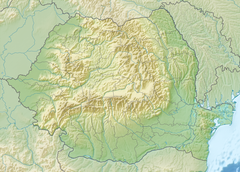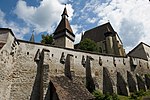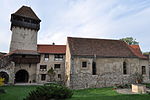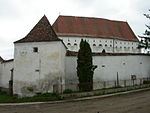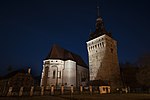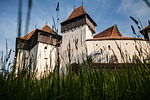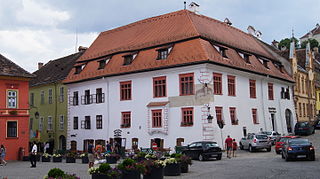
Sighișoara is a municipality on the Târnava Mare River in Mureș County, central Romania. Located in the historic region of Transylvania, Sighișoara had a population of 23,927 according to the 2021 census. It is a popular tourist destination for its well-preserved old town, which is listed by UNESCO as a World Heritage Site. The town administers seven villages: Angofa, Aurel Vlaicu, Hetiur, Rora, Șoromiclea, Venchi, and Viilor.

Mediaș is the second largest town and municipality in Sibiu County, Transylvania, central Romania.

Agnita is a town on the Hârtibaciu river in Sibiu County, Transylvania, central Romania. It is considered the locality in the center of the country. The town administers two villages, namely Coveș and Ruja.

The Transylvanian Saxons are a people of mainly German ethnicity and overall Germanic origin —mostly Luxembourgish and from the Low Countries initially during the medieval Ostsiedlung process, then also from other parts of present-day Germany— who settled in Transylvania in various waves, starting from the mid and mid-late 12th century until the mid 19th century.
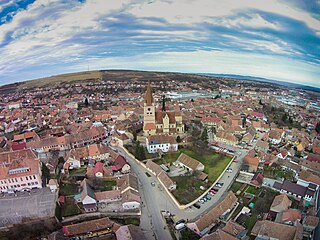
Cisnădie is a town in Sibiu County, Transylvania, central Romania, approximately 10 kilometres (6.2 mi) south of Sibiu. It comprises the main town of Cisnădie and one village, Cisnădioara.
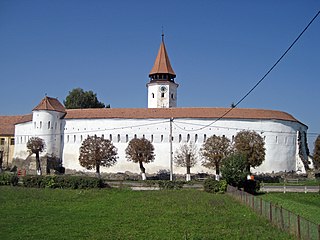
Prejmer is a commune in Brașov County, Transylvania, Romania. It is composed of three villages: Lunca Câlnicului (Farkasvágó), Prejmer, and Stupinii Prejmerului. Located 18 km (11 mi) northeast of Brașov, the Olt River passes through the commune.

Biertan is a commune in Transylvania, Romania. The commune is composed of three villages: Biertan, Copșa Mare, and Richiș, each of which has a fortified church.

Dumbrăveni is a town in the north of Sibiu County, in the centre of Transylvania, central Romania. The town administers two villages, Ernea and Șaroș pe Târnave.

Bunești is a commune in Brașov County, Transylvania, Romania. It is composed of five villages: Bunești, Criț, Meșendorf, Roadeș, and Viscri. Each of these has a fortified church. The route of the Via Transilvanica long-distance trail passes through the villages Roadeș and Criț.

Brateiu is a commune located in Sibiu County, Transylvania, Romania. It is composed of two villages, Brateiu and Buzd, each of which has a fortified church. There is a burial ground located here which is dated to the 4th century. The Daco-Roman cemetery is situated on the bank of the Târnava Mare river, and is estimated to date to between 380–454 AD.

Șura Mare is a commune located in Sibiu County, Transylvania, Romania. It is composed of two villages, Hamba and Șura Mare. Șura Mare was first mentioned in 1332, and Hamba in 1337.

A fortress church is a particular type of church that, in addition to its religious functions is also used by the local population as a retreat and defensive position, similar to a refuge castle. A fortress church usually implies that the church is enclosed by its own fortifications, such as curtain walls and defensive towers. By comparison, a church with simple defensive features, such as battlements and embrasures on the church itself, is usually just referred to as a fortified church.
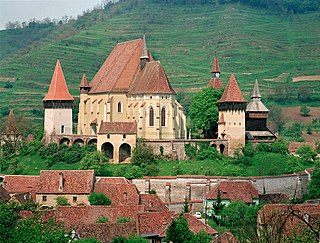
The Biertan fortified church is a Lutheran fortified church in Biertan, Sibiu County, in the Transylvania region of Romania. It was built by the ethnic German Transylvanian Saxon community at a time when the area belonged to the Kingdom of Hungary. Briefly Roman Catholic, it became Evangelical Lutheran following the Reformation. Together with the surrounding village, the church forms part of the villages with fortified churches in Transylvania UNESCO World Heritage Site.

The Câlnic Fortress is a fortress located in Câlnic, Alba County, in the Transylvania region of Romania. It was built by a nobleman whose family later sold it to the local ethnic German Transylvanian Saxon community at a time when the area belonged to the Kingdom of Hungary. When still used for defensive purposes, the double walls encompassed a residential keep, storerooms and a Roman Catholic chapel that became Lutheran following the Reformation. Together with the surrounding village, the fortress forms part of the villages with fortified churches in Transylvania UNESCO World Heritage Site.

The Prejmer fortified church is a Lutheran fortified church in Prejmer (Tartlau), Brașov County, in the Transylvania region of Romania and the ethnographic area of the Burzenland. The church was founded by the Germanic Teutonic Knights, and then was eventually taken over by the Transylvanian Saxon community. Initially Roman Catholic, it became Lutheran following the Reformation. Together with the surrounding village, the church forms part of the villages with fortified churches in Transylvania UNESCO World Heritage Site.

The Saschiz fortified church is a Lutheran fortified church in Saschiz (Keisd), Mureș County, in the Transylvania region of Romania. It was built by the ethnic German Transylvanian Saxon community at a time when the area belonged to the Kingdom of Hungary. Initially Roman Catholic, it became Lutheran following the Reformation. Together with the surrounding village, the church forms part of the villages with fortified churches in Transylvania UNESCO World Heritage Site.
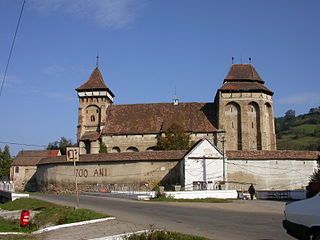
The Valea Viilor fortified church is a Lutheran fortified church in Valea Viilor (Wurmloch), Sibiu County, in the Transylvania region of Romania. It was built by the ethnic German Transylvanian Saxon community at a time when the area belonged to the Kingdom of Hungary. Initially Roman Catholic, it became Lutheran following the Reformation. Together with the surrounding village, the church forms part of the villages with fortified churches in Transylvania UNESCO World Heritage Site.

The Viscri fortified church is a Lutheran fortified church in Viscri (Deutsch-Weisskirch), Brașov County, in the Transylvania region of Romania. It was built by the ethnic German Transylvanian Saxon community at a time when the area belonged to the Kingdom of Hungary. Initially Roman Catholic, it became Lutheran following the Reformation. Together with the surrounding village, the church forms part of the villages with fortified churches in Transylvania UNESCO World Heritage Site.

St. Margaret's Church is a Lutheran church, located at 1 Piața Castelului in the historic town center of Mediaș (Mediasch), Sibiu County, in the Transylvania region of Romania.

The Transylvanian Saxon culture refers to the regional culture of the Transylvanian Saxons, an ethnic German group which has been living in Transylvania, present-day central Romania since the mid and mid-late 12th century onwards, thus being one of the oldest groups of the German diaspora still residing in Eastern and Central Europe, alongside the Baltic Germans and the Zipser Germans.

